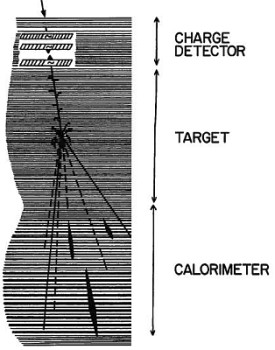Purpose of the flight and payload description
The Japanese American Collaborative Emulsion Experiment (JACEE) was a scientific effort carried out to measure the composition and spectra of primary cosmic rays at the top of the atmosphere, using emulsion chambers transported by stratospheric balloons. JACEE's first flight was conducted in 1979, and flights continued through 1996, totaling 14 flights and 13 successful missions. The collaboration leveraged Japanese expertise in photographic materials and microscopy, American expertise in ballooning and data analysis, and Polish resources in scanning and measurement of emulsions.
Each payload could contain one, three, or four chambers, each chamber with an area about 2000 cm2, 12~25 cm thick, and weighing ~120 kg. Figure at left shows a schematic diagram of the vertical configuration of one chamber. It was comprised of four sections, identifiable according to their function in the experiment. These are, from the top, the charge detector, the target, the spacer, and the calorimeter. All sections were multilayered stacks of track-sensitive materials (emulsions, x-ray films, CR-39, Lexan) alternated with absorbers (acrylic, lead). There were approximately 300 layers of emulsion in the chamber. This configuration was more or less the same for all the flights. However, many flights not included the spacer section, and in some cases were added other elements like Cerenkov detectors or plastic scintillators.
The charge detector employed thick (200 - 400 micron) emulsions, which permited accurate determination of the charge of each primary particle via measurements of the grain density, gap distribution, and/or delta ray distribution. The target section was comprised basically of thin (50 ~ 75 micron) emulsion plates alternated with acrylic sheets. The substantial mass of low-Z material maximized the interaction probability, while the emulsion optimized the observation of charged tracks from an interaction vertex. In order to identify nuclear fragments, charge identification layers composed of thick emulsions and etchable plastics were inserted at regular intervals throughout the target.
The spacer section consisted of honeycomb paper with a few thin emulsions positioned at regular intervals that facilitated the tracing of tracks through it. Finally, the calorimeter was the energy measuring portion of the apparatus. It consisted of 1.0 and 2.5 mm thick lead sheets alternating with thin emulsion plates and x-ray films. Gamma rays emanating from a vertex in the target initiated electro-magnetic cascades in the calorimeter. The cascades produced dark spots in the x-ray films, the observation of which provided the trigger for an event. The events were traced back from the calorimeter, through the spacer, to the vertex in the target by observing associated tracks in the emulsions.
This was a long duration flight of JACEE so several addaptations were needed on the chambers. Due to the distance, all the data instead being telemetered to a ground station were recorded onboard, including temperature and pressure altitude readings. For this purpose was built a data recorder employing high-density memory chips. An aneroid control system was also used to shift a topside film layer out of registration with the main emulsion chambers when pressure altitude dropped below a preset level. Shifter status was included in the data transmitted to NSBF by the ARGOS satellite tracking system.
Details of the balloon flight

Balloon launched on: 1/25/1987
Launch site: Australian Balloon Launching Station, Alice Springs, Australia
Balloon launched by: National Scientific Balloon Facility (NSBF)
Balloon manufacturer/size/composition: Zero Pressure Balloon
Flight identification number: 212N
End of flight (L for landing time, W for last contact, otherwise termination time): 1/31/1987
Balloon flight duration (F: time at float only, otherwise total flight time in d:days / h:hours or m:minutes - ): 6 d 6 h
Landing site: In Concepcion, Paraguay
The balloon was launched from Australia on January 25, 1987 and after crossing the Pacific Ocean, it was meant to be terminated over Brazil. However, an unanticipated sudden altitude loss resulted in the automatic flight termination over a raging thunderstorm in northern Paraguay. The payload landed near the city of Concepcion and despite logistical and diplomatic difficulties, it was returned to the US after several weeks' storage at local ambient temperatures. Although background fog levels in the emulsions and x-ray films were higher than usual, the payload was fully analyzable, and data was obtained from it.
This was the first long duration mission of the JACEE program and the seventh flight since the inception of the program in 1979. Total exposure time at float was of 150 hours.
External references
- JACEE experiment website Institute of Nuclear Physics PAN, Poland
- JACEE experiment website University of Washington Particle Astrophysics Group
- Balloon fails to circle the globe The Free Lance-Star, 2 Feb 1987
- Cosmic-Ray Proton and Helium Spectra: Results from the JACEE Experiment Astrophysical Journal Vol. 502 Pag 278, 1998
- Elemental abundance of high energy cosmic rays Nuclear Physics B - Proceedings Supplements - Vol. 60, Issue 3, p. 83
- High Energy Gamma Rays above 3 TeV Observed by Balloon-Borne JACEE Emulsion Chambers 24th International Cosmic Ray Conference, Vol. 2, held August 28-September 8, 1995 in Rome, Italy
- NASA Completes Long-Duration Balloon Flights, Payloads Recovered Goddard News Vol. 33 Nº 3, March 1987, pag. 5
- Wallops Conducts Launch Down Under Goddard News Vol. 33 Nº 12, December 1987
12177If you consider this website interesting or useful, you can help me to keep it up and running with a small donation to cover the operational costs. Just the equivalent of the price of a cup of coffee helps a lot.



